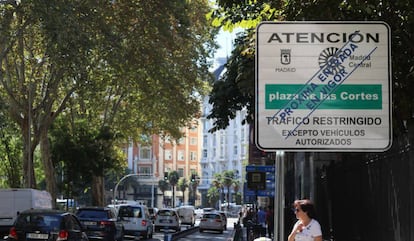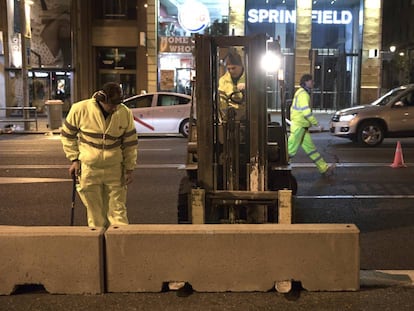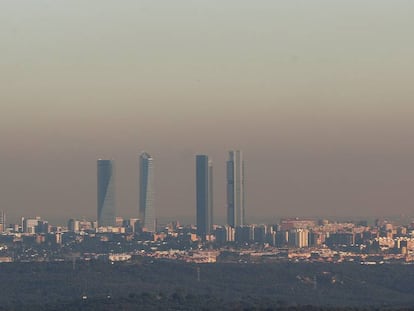Madrid announces new rules of the road in bid to banish traffic from center
City is about to approve a raft of new regulations that will cover electric scooters, pedestrians, motorbike parking and bicycles

Madrid City Council is set to approve a new Sustainable Mobility Ordinance that will change the way residents move around public spaces.
The new measures, which will take effect between five and 15 days after the council approves them on Friday, introduce a speed limit of 30km/h on all one-way streets and on single-lane two-way streets.
Under the new rules, motorcycles will not be allowed to park on sidewalks less than three meters wide or near pedestrian crossings. Bicycles will be able to make right turns at red lights where indicated. And new traffic restrictions will go into effect in the downtown area on November 23.
The ordinance may still be partially amended before passage on Friday, but here are some of its key components.

New speed limits
Besides the 30km/h limit on one-way streets and single-lane two-way streets, the city will slow traffic down to 20km/h on streets where the sidewalk is not elevated above road level, such as in the neighborhoods of Lavapiés and Chueca. The 30km/h rule will affect 80% of Madrid’s streets – not just in the downtown area. These measures aim to increase road safety and reduce the chance of accidents involving pedestrians.
Pedestrians
The spirit of the new ordinance is to favor sustainable mobility. New signs will indicate the presence of “Zonas 30,” where pedestrians may cross the street at any spot after checking that they are not running a risk or slowing down traffic. And in “Calles 20,” pedestrians will have priority over vehicles. The city is also planning to roll out more traffic lights with incorporated cameras, and to designate “pedestrian special protection spaces” where neither motorcycles nor bicycles will be allowed to park.
Bicycles
Bicycles will be able to turn right on a red light where so indicated. They may also move against the traffic on residential streets with speed limits of 20km/h or under, and on shared-use lanes. The 30km/h speed limit on many streets also seeks to favor shared road space between motorists and cyclists. The latter will also be allowed to lock their bikes to street furniture as long as they don’t block the way for pedestrians.
Motorcycles and mopeds
Until now, motorcycles could be freely parked on sidewalks. The new rules will prohibit this on sidewalks under three meters wide, and less than five meters from a pedestrian crossing. Motorcycles will also have to be more than two meters away from bus stops. On the other hand, there is now twice as much dedicated parking space for motorcycles in the Centro district
Skates and scooters
People on skates, kick scooters or other devices without a motor may use the sidewalks and other pedestrian areas as long as they travel at an appropriate speed. They may also use cycling lanes and other areas adapted for bicycles. On lanes used by pedestrians, the maximum allowed speed is 5km/h. Motorized scooters and other personal mobility vehicles will no longer be allowed on sidewalks and other pedestrian spaces, and will instead have to use bicycle lanes.
Traffic restrictions
The newest element in the new regulations is Madrid Central, a restricted traffic area that will apply to most of the city’s Centro district starting on November 23. Residents may enter the area in their vehicles but only park in their own neighborhood. Occasional visitors may be allowed in by residents. Non-residents whose vehicles hold CERO and ECO energy labels may also enter the area. And those with B or C energy labels may only enter to park in a private or public parking lot, not in the street. Exceptions will also be made for people with reduced mobility, ambulances, taxis, private-hire cars and delivery vans. Electric vehicles will also be allowed into Madrid Centro.
Public transportation
City officials note that there are 60 bus lines going through Madrid’s downtown area, as well as six subway lines and eight underground train lines. There are also 57 BiciMad public bicycle rental docking stations.
English version by Susana Urra.
Tu suscripción se está usando en otro dispositivo
¿Quieres añadir otro usuario a tu suscripción?
Si continúas leyendo en este dispositivo, no se podrá leer en el otro.
FlechaTu suscripción se está usando en otro dispositivo y solo puedes acceder a EL PAÍS desde un dispositivo a la vez.
Si quieres compartir tu cuenta, cambia tu suscripción a la modalidad Premium, así podrás añadir otro usuario. Cada uno accederá con su propia cuenta de email, lo que os permitirá personalizar vuestra experiencia en EL PAÍS.
¿Tienes una suscripción de empresa? Accede aquí para contratar más cuentas.
En el caso de no saber quién está usando tu cuenta, te recomendamos cambiar tu contraseña aquí.
Si decides continuar compartiendo tu cuenta, este mensaje se mostrará en tu dispositivo y en el de la otra persona que está usando tu cuenta de forma indefinida, afectando a tu experiencia de lectura. Puedes consultar aquí los términos y condiciones de la suscripción digital.
More information
Archived In
Últimas noticias
Mexico seeks to shore up its defenses following US incursion in Venezuela
Hope gives way to uncertainty among Venezuelan exiles in the US after Maduro’s capture
Cubans look to Venezuela fearfully after Trump’s incursion: ‘We could be next’
The operation in Venezuela to capture Maduro threatens to widen the cracks in the MAGA movement
Most viewed
- Alain Aspect, Nobel laureate in physics: ‘Einstein was so smart that he would have had to recognize quantum entanglement’
- Gilles Lipovetsky: ‘If you want to live better and fall in love, take Prozac, don’t look to philosophy’
- Alvin Hellerstein, a 92-year-old judge appointed by Bill Clinton, to preside over Maduro’s trial in New York
- Cuba confirms death of 32 of its citizens in the US attack against Venezuela
- Why oil has been at the center of Venezuela-US conflicts for decades










































